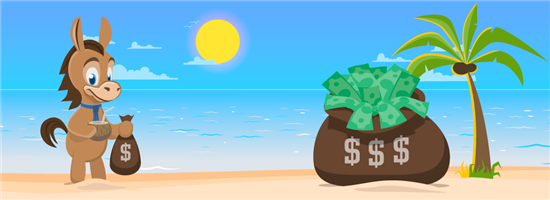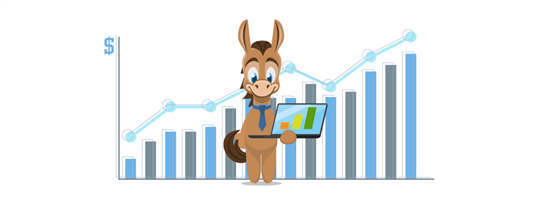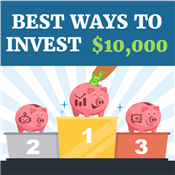Best Ways to Invest $20,000
Ad Disclosure: This article contains references to products from our partners. We may receive compensation if you apply or shop through links in our content. This compensation may impact how and where products appear on this site. You help support CreditDonkey by using our links.
What to do with $20k? Learn how to invest your savings (plus 3 investments to avoid). Imagine what it could be worth in 20 years.
 |
| © CreditDonkey |
You did it! Building a nest egg of $20,000 wasn't easy. Now it's time to think about longer-term goals.
- Buy a house?
- Start a business?
- Level up in your career?
Whatever your goals are, it pays to invest wisely and do thorough research. In this guide, review 10 ways to invest $20,000 for a secure future, five unconventional ideas, plus three important issues to take care of first.
- Invest in Stocks
- Invest in Mutual Funds or ETFs
- Invest in Bonds
- Try a Robo-Advisor
- Consider Real Estate Investing
- Bulk up your Retirement Accounts
- Open a Certificate of Deposit
- Fill a High-Yield Savings Account
- Open a Brokerage Account
- Try Peer-to-Peer Lending
What to Do Before You Invest
 |
| © CreditDonkey |
Before you invest your money, give your financial situation an honest review to make sure you're on solid footing first.
Pay Down High-Interest Debts
If you have a lot of personal debt, it's best to pay that down first. In fact, paying off debts can be just as profitable as investing and healthier for your finances in the long run.
For example, say you're expecting a 5% return on your investment, but you currently have credit card debt with a 23% APR. If you invest instead of putting those funds toward credit card debt, you would be losing money.
Keep in mind that some lower-interest debt, such as an auto loan or home mortgage, is OK to hold while making investments. That's because the debt has a fixed timeline and the interest is usually lower (less than 6-7%).
Create an Emergency Fund
An emergency fund is a sum of money you save up for unexpected expenses. These can include medical bills, home repairs, job loss, and other unanticipated events.
Experts suggest having at least 3-6 months' worth of expenses stashed away in a safe, yet accessible account.
Before putting all $20,000 into an investment, make sure that you have an emergency fund in place to protect your financial wellbeing in case of an emergency.
Secure Your Retirement
If your debt is under control, ask yourself whether you're on track to meet your retirement goals:
- Do you have a 401(k)?
- Does your employer match contributions?
First, be sure to enroll in any 401(k) plan that is available to you. Then, check with your company HR department to see what percentage your company matches. Contribute at least that amount—otherwise, you're turning down free money.
Even if your company doesn't match, try to contribute the maximum amount before you invest $20,000 elsewhere. That will boost your retirement savings and lower your taxable income.
How to Invest $20,000
 |
| © CreditDonkey |
Once your debt is under control and your retirement plan is on track, you can explore different options for investing $20,000.
1. Invest in Stocks
Risk level: High
Best for: Investors okay with taking on risk
If you do invest in stocks, create a plan first. Set the amount you want to invest and understand your personal capacity for potential losses.
When you're ready to begin, consider using an online brokerage account, such as Ally Invest, or one of many others. If you're completely new to investing, choose a company that offers a simple interface and educational resources.
Once you choose an online broker, create your account.
Review stock performance histories and professional forecasts, then choose one or two stocks that match your risk tolerance to start your investment. Hold off on investing a lot until you have a good handle on the process.
If you take a loss, weigh the risks again to decide whether to pull or keep your investment.
2. Invest in Mutual Funds or ETFs
Risk level: Moderate
Best for: Instant diversification
Mutual funds and ETFs offer diversification. Rather than investing in one company as with stocks, a mutual fund or ETF diversifies among stocks, bonds, and other short-term investments.
First, choose a brokerage. Charles Schwab, Vanguard, and Fidelity are some of the most popular. You can also research brokerages that currently offer promotions to maximize your earnings.
Longer-term goals, such as retirement, do well with index funds. These funds mimic a specific index, such as the S&P 500. They offer diversification and a long-term investment strategy. The returns on index funds closely mimic market returns. They require very little management and often have lower fees.
Choose the fund with the lowest expense ratio, as minimizing costs is the key to maximizing net returns.
TD Ameritrade: Commission-Free Trading - Online Stock, ETF and Option Trades
Applies to U.S. exchange-listed stocks, ETFs, and options. A $0.65 per contract fee applies for options trades, with no exercise or assignment fees.
3. Invest in Bonds
Risk level: Low
Best for: Balancing an already risky portfolio
Buying a bond is basically just buying debt. You can invest in them much like you would stocks (read our guide for more information about the differences between stocks and bonds).
In general, bonds tend to be more predictable than stocks. There are three main types:
- Corporate, which are offered by corporations looking to raise capital
- Municipal, which are issued by cities and states to fund public projects
- Treasury, or T-bonds, which can be purchased directly from the U.S. government
With bonds, you can also calculate your return before you purchase a bond based on the rate and period of maturity.
As with any investment, bonds do carry some risk. For example, when interest rates rise, bond prices fall. This means that if you choose to sell a bond before its maturity date, you could make less than the price you paid for it.
Bonds generally must be purchased through a broker, while T-bonds can be bought directly from the government.
4. Try a Robo-Advisor
Risk level:High
Best for: Beginners or hands-off investors
If $20,000 isn't enough for a financial advisor to take you on as a client, consider a robo-advisor. A robo-advisor is an automated advisor program that does much, or all, of the work for you.
Once your investments are in place, a robo-advisor can also automatically rebalance your portfolio (see our guide on Why Consider a Robo-Advisor for more information).
5. Consider Real Estate Investing
Risk level: High
Best for: High potential returns and rental income
A good way to start earning passive income on your $20,000 investment is with real estate investing. Many invest in real estate through investment vehicles like real estate investment trusts (REITs) or real estate crowdfunding.
You can invest in a share of a REIT just like you would invest in a stock. REITs provide profits through the rental income they collect from properties or property appreciations, among other ways.
Fundrise and RealtyMogul are two popular online real estate investing platforms that offer a variety of investment opportunities. Do some research about what kind of real estate investment would work best for you (commercial, residential, REITS, and more) before deciding where to put your money.
Invest in Real Estate with $10+
- Only $10 minimum investment
- Get a diversified portfolio of real estate projects across the US
- Open to all investors
6. Bulk up your retirement accounts
Risk level: Varies depending on your investments
Best for: Investors with modest retirement savings in place
If you already have a retirement account, consider stashing your $20,000 to give it a big boost. You might even consider opening a traditional IRA or Roth IRA to supplement your long-term savings.
These retirement accounts also have tax advantages. As of 2022, you can contribute up to $6,000 per year, or $7,000 if you are over 50.[2]
With a traditional IRA, you can deduct the amount you contribute from your annual taxable income. For a Roth IRA, you cannot deduct that amount, but you'll be able to withdraw the funds for retirement tax-free.[3]
If you're self-employed, your retirement savings options can include starting a 401(k) or a SEP (Simplified Employee Pension) IRA. Check with a tax professional to review your options.
7. Open a Certificate of Deposit
Risk level: Low
Best for: Safe, modest, guaranteed returns
If you are looking for a risk-free investment with decent returns, consider investing your $20,000 in CDs. We recommend using an online bank rather than a traditional bank like Chase because they tend to offer higher rates.
With CDs, the longer you invest the money, the higher the APY (annual percentage yield) you'll earn. Keep in mind that CDs with higher APYs also come with higher account minimums.
Before choosing a CD, consider the minimum deposit required, the yield rate, and the term length. Remember, you cannot withdraw your money from a CD before the term is up. If you're absolutely sure you won't need your money for a specific amount of time, choose a CD term for that length of time.
High-Yield CD Rates - Up to 4.30% APY
- No fees
- $1 minimum deposit
- FDIC insured
| Term | CD Rates |
|---|---|
| 3 Month | 4.30% APY |
| 5 Month | 4.10% APY |
| 6 Month | 4.30% APY |
| 9 Month | 3.95% APY |
| 12 Month | 3.95% APY |
8. Fill a High-Yield Savings Account
Risk level: Low
Best for: Safe, short-term investing
When we talk about savings accounts, we don't mean the account at your local bank. We mean online savings accounts where you might find much higher rates.
One such account with a high APY is CIT Bank's Platinum Savings (read our review). Take a look at our CIT promo code page to learn more.
You should consider a few things before you invest. First, keep in mind that current interest rates are fairly low, so your returns will be modest. Also, make sure the FDIC insures the bank. Finally, read the fine print regarding withdrawals and transfers, as some banks charge or even penalize them.
Check for required account minimums too. If you prefer a debit card, look for banks that offer this service.
CIT Bank Platinum Savings - $300 Bonus
- Transfer a one-time deposit of $50,000+ for a Bonus of $300
- 4.10% APY with a balance of $5,000 or more
- 0.25% APY with a balance of less than $5,000
- No monthly maintenance fee
- Member FDIC
9. Open a brokerage account
Risk level: Varies depending on your investments
Best for: Investors who want multiple options on one platform
Undecided on what to invest in? Opening a brokerage account gives you a lot of options.
Brokerages like Vanguard, Fidelity, or TD Ameritrade can offer multiple investments, including retirement accounts, mutual funds and ETFs, and much, much more.
Depending on what type of brokerage you choose, you may be required to make a minimum opening deposit, but $20,000 is likely enough to meet that requirement. Otherwise, you can find a discount broker that doesn't charge as much.
10. Try Peer-to-Peer Lending
Risk level: High
Best for: Risk-friendly investors
Peer-to-peer lending (P2P) is a newer method of investing and an especially good choice for those who don't want to deal with a financial institution. Instead, you become the lender. By joining a P2P platform, you can connect with borrowers all over the world.
Platforms like Prosper work as the intermediary between you and the borrower.
They distribute the loans to borrowers (funded by you), collect payments, and help with litigation if the borrower defaults. You can even diversify your risk by lending money to multiple borrowers at once. Your $20,000 could fund many borrowers with low borrowing needs.
While P2P can offer a high rate of return, there is always a risk of your borrower defaulting on their loan.
Unconventional Ways to Invest Your $20,000
Sometimes you want something a little different. If you're looking for some more creative ways to invest your $20,000, don't miss the ideas below. You might be surprised by how lucrative they can be.
Invest in Your Home
If parts of your home are outdated or need a facelift, certain improvements can have a direct impact on your home's value.
You don't need to make drastic changes to see a large improvement in value (in fact, some major bathroom and kitchen remodels often don't have a large return on investment). New siding, a new roof, or new windows are more worth your time and money.
However, certain small changes in a kitchen or bathroom, such as the addition of granite countertops, often pay off. Another change with a large return on investment (ROI) is updating the home's curb appeal. You may even get a tax break for improvements made in energy efficiency.[4]
Start Your Own Business
If you are tired of the 9-to-5 grind, investing $20,000 in your own business could be your chance to break free. But you'll need a great idea—and a solid business plan—before seriously considering starting your own business.
Before starting a business, it's always a good idea to consult professionals and take advantage of any available resources. We recommend visiting the Small Business Administration's website for advice on how to get started. They offer many resources and steps for beginner and experienced business owners.
Invest $20,000 in Yourself
You can also use your savings to take an educational course that can improve your career and your earning prospects. With this strategy, you could easily turn $20,000 into much larger earnings.
Here are some ways you can invest $20,000 in yourself:
- Take a class or a workshop: Seminars, higher-education courses and mentorship programs can help build your network to move up in your job.
- Hire a business or career coach: Identify long-term goals to start your own business or side hustle.
- Invest in your health: The right food and consistent exercise allow you to grow professionally and personally.
- Learn a new skill: Keep your mind sharp and nimble or level up your marketable skills for a new career
Try Fulfillment by Amazon
With $20,000, you can get going with a retail business through Fulfillment by Amazon.
Essentially, you ship the items you want to sell to Amazon, which then fulfills any orders you get and ships your products for you. Rates vary by the sizes of the packages shipped and the amount of warehouse space you'll need, but $20,000 should be plenty to get a small operation going.
You'll have access to Amazon's large marketplace of buyers, and you only do a fraction of the work involved with other selling sites. It almost provides immediate gratification. You can sell new or used items.
Start a Blog
If you're a DIY kind of person, consider starting a blog. Many people use blogs as a side gig and eventually earn money as an affiliate partner with different businesses.
Blogs have the potential to make you a steady stream of income through advertising, and $20,000 is more than enough to start one.
You'll likely need some of that money to buy a domain name and web hosting service. Or, you may need to invest in equipment like video recorders, microphones, cameras, or a better computer.
Start a Podcast
The podcast world is increasingly difficult to break into, but there is still room to make money. You should be prepared to dedicate a lot of time and energy to producing regular content.
But, if it's something you enjoy doing, you may find the advertising deals you can get by podcasting to be lucrative. Plus, $20,000 would set you up pretty well with all the necessary equipment and even some marketing costs.
The 3 Investments You Should Avoid
Some types of "investments" aren't really investments at all. In fact, you could easily lose your $20,000 if you put it into a risky scheme.
Here are some examples of what to avoid when looking to invest $20,000:
- Pyramid Schemes. You may have heard of businesses that promise to make you rich if you can recruit others to join them. If you're asked to pay to join a business with that type of model, be aware that it may be a pyramid scheme. These schemes will rarely make you as much money as they promise to.
- Penny Stocks. Stocks that you can buy for less than $5 may seem like a great deal. After all, with $20,000, you could buy a lot of these shares. But usually, they're not profitable at all.
Companies that offer penny stocks are often very small and are required to disclose their financials. They may be trying to raise capital to grow, but they're not always successful in the long run.
- Gambling. Yes, you could possibly win big with gambling $20,000, but people rarely do. Statistically, you are much more likely to lose your money when you gamble. That's true whether you are playing in a casino or buying a lottery ticket. The odds are not in your favor, so while gambling may be entertaining, it's a poor investment choice.
What the Experts Say
CreditDonkey asked a panel of industry experts to answer readers' most pressing questions. Here's what they said:
Bottom Line
Fortunately, you have many options for how to invest $20,000, from investing in the stock market to launching your own business. Weigh the pros and cons of each option to find the best strategy for you.
Remember, before you invest, give your finances a health checkup to make sure you are in the best position to start investing. And beware of risky investments like penny stocks and pyramid schemes, which may not be what they seem.
The bottom line is that the sooner you can start investing your funds in a safe way, the more you can benefit from the rewards of your investment.
References
- ^ U.S. Bureau of Labor Statistics. How Does Your 401(k) Match Up?, Retrieved 2/22/2022
- ^ Internal Revenue Service. Retirement Topics - IRA Contribution Limits, Retrieved 2/22/2022
- ^ Internal Revenue Service. Traditional and Roth IRAs, Retrieved 2/22/2022
- ^ Energy Star. Federal Income Tax Credits and Other Incentives for Energy Efficiency, Retrieved 2/22/2022
Write to Rebecca M at feedback@creditdonkey.com. Follow us on Twitter and Facebook for our latest posts.
Note: This website is made possible through financial relationships with some of the products and services mentioned on this site. We may receive compensation if you shop through links in our content. You do not have to use our links, but you help support CreditDonkey if you do.
Fundrise, LLC ("Fundrise") compensates CreditDonkey Inc for new leads. CreditDonkey Inc is not an investment client of Fundrise.
|
|
|








